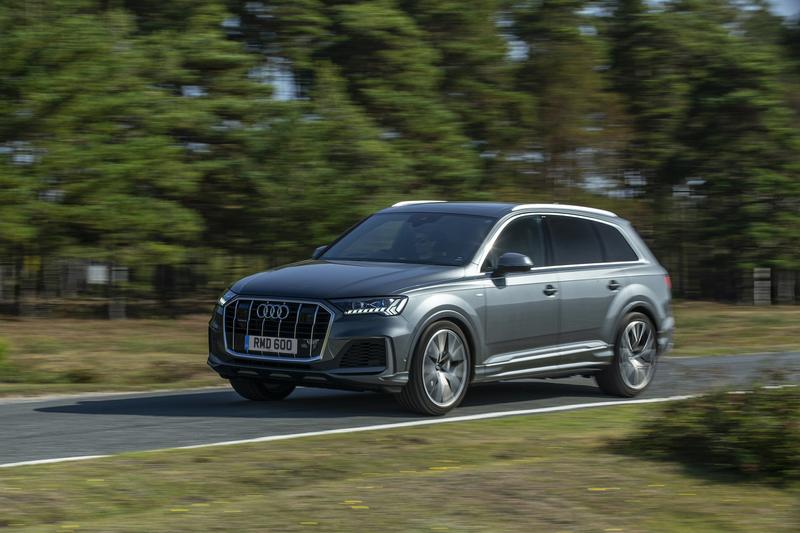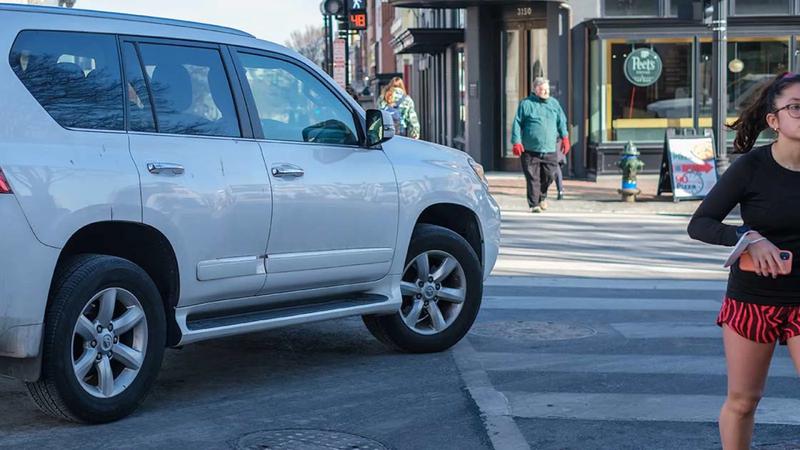Julian Kirk finishes his test drive of the Q7 PHEV with a look at the merits of running a PHEV in the current marketplace
P11d/BiK: £69,165 (16%) MPG/CO2: 108.6mpg/59g/km Test mpg: 52.3mpg
Our test of the Q7 longtermer has found that it’s s a quality, roomy and comfortable car with all the attractions of the Audi badge
Report 5
To wrap up our coverage of life with the plug-in Q7, I thought it worth looking at where the car sits compared with its rivals. Does a plug-in beat a diesel in the real world? Is a five-seat Q7 really worthwhile? Is it best in class?
Let’s answer the first question… plug-in Q7 vs a diesel 45 TDI S line model. For company car tax, the plug-in is a clear winner (£372 a month in BIK vs £743 in the TDI). And even if you ignore the optimistic claimed fuel economy of 108mpg, the plug-in still beats the TDI’s 35.3mpg claimed in the real world – we averaged low to mid 50s throughout our time with the plug-in. However, the TDI is about £9,000 cheaper at the front-end and comes with seven seats as standard (unlike the plug-in).
Question two: is a five-seat Q7 worthwhile? Well, it depends on what you want from it. With two young children and the frequent need to transport them and their friends at weekends, a seven-seater is essential. On the flip side, the Q7’s boot is massive and the cabin super-roomy so it really does make a capable and capacious car. However, the fly in the ointment is that the Q7’s key rivals (Volvo XC90, Mercedes-Benz GLE) both come with seven seats as standard.
Finally, is the plug-in Q7 best in class? On paper, it’s neck and neck with its closest rival, the XC90 Recharge T8 R Design… the Volvo is slightly cheaper at the front-end (£68,420 vs £69,915), shares the same 16% BIK banding and is, therefore, slightly cheaper in company car tax (at £364 a month it’s £8 cheaper than the Q7) but has lower claimed fuel economy (100.9 vs 108.6mpg). None of which is enough to swing the deal either way. For me, the XC90’s seven-seat capability seals it.
So where does that leave the Q7? In isolation it’s a quality, roomy and comfortable car with all the attractions of the Audi badge. But as an all-round package it is hampered by its five-seat layout. This Q7 feels like a stepping stone to greater things when the next generation is revealed… unlike its successor on the long-term test fleet – you can read more about our new e-tron next time.
Julian Kirk
The fit and finish in the cabin is top-notch
Report 4
There are myriad features on the Q7 designed to make life easy, such as the push button boot close, automatic wipers and headlights, etc…
But one of the handiest features of the Q7 is a cheap, unobtrusive piece of cloth which lives in the glovebox. This special cloth is provided to help rid the touchscreens of finger prints – and because pretty much every function of the Q7 needs to be accessed via the two touchscreens, they amass an awful lot of greasy fingerprints.
While these screens look great and are undoubtedly clever (the haptic feel of pressing a non-existent button is impressive), until they invent humans with grease-free fingers, they are always going to look a mess after a couple of uses.
Remaining inside the Q7’s cabin, the fit and finish is top-notch, and the design is clean and crisp, but I do wish Audi would allow for some different colour combinations… S line trim limits you to black seats and dashboard with a few slivers of silver relief.
The panoramic roof does a good job of lightening things up, but it’s a £1,850 option – pricey on a car already costing nearly £70,000.
Elsewhere, a new puppy has arrived with us which is highlighting just how big the Q7’s boot is. The ability to swallow a large dog travel crate and still allow room for other paraphernalia makes this Q7 a family favourite. And as our children are small, sliding the back seats forward generates even more luggage room while still not putting their legs near to the backs of the front seats.
While the Q7 hybrid’s outright functionality is impinged by the lack of a seven-seat option (no space for them as the batteries take over the boot floor), it still offers a lot of versatility.
Our Q7 long-termer can be charged in less than two hours with the new home charger

Report 3
The arrival of a Pod Point Solo home charger has changed the dynamic between the Q7 and me.
Previously, charging with a three-pin lead was, to be honest, a faff – position the car in exactly the right place on the drive to meet the charging cable that I’d been into the garage to connect and thread under the garage door, before plugging it in and waiting for about 12 hours for the battery to charge up.
Now, thanks to the Solo’s seven-metre cable I can just retrieve the lead, plug it in and, within two hours, the battery is charged and ready.
Reducing the charging time so dramatically makes me more inclined to plug in and recharge – before, I was guilty of being one of those hybrid drivers who often drive around with the battery empty, relying purely on ICE power.
But even so, the charge doesn’t last long. The claimed 30-mile range actually translates into about 18 miles on pure EV power – fine for short commutes, but quickly spent on a longer journey. Having
sampled two lighter Audi plug-ins recently (A3 and, to a lesser extent, A6) the EV range is a genuine 30-odd miles, which is a good compromise. The problem with the Q7 is it is a heavy car, so the charge disappears much more quickly.
So on paper, the Q7 looks attractive (16% BIK is a bonus for such a vehicle) but in the real world it feels like a slightly limited EV and a compromised SUV (big petrol engine and no seven-seat capability as the battery pack takes up the boot floor).
A quick home remedy sorted the software glitch
Report 2
There’s an eerie sound of silence when driving the Q7 – and it’s not just because of its EV capability. Our car has been struck by a software glitch which has rendered the MMI system inoperable – so no music, no navigation, no Bluetooth for the phone.
Faced with a visit to the local dealership (and the time involved), I resorted to the Web to see if any other owners have had the same experience. Thankfully, there were a few owners reporting similar problems – the MMI screen just displaying a generic warning.
According to the owners online, the problem is usually caused by an ‘over-the-air’ software update – this one had obviously gone wrong somewhere along the line. They also offered a quick solution – hold down the volume button on the centre console for 20 seconds to re- boot the MMI system.
Twenty seconds later and the MMI is firing on all cylinders again and I am happy that I won’t have to spend a morning at my local dealer. It would appear that the IT department mantra of ‘have you tried turning it off and starting it up again’ applies equally to cars as well as computers.
Julian Kirk
Our new Q7 longtermer
Report 1
It’s a mark of how much cars have changed in recent years that the Audi Q7 no longer feels that big. When it was originally launched it was a behemoth, but nowadays it is dwarfed by models such as the Land Rover Discovery and BMW X7.
That’s not to say it’s small – inside it is cavernous and the boot is vast – but it doesn’t feel intimidating to drive… more like an A6 on stilts. And from behind the wheel you could be in an A6 because both models share the new Audi interior design featuring more touchscreens than PC World and a sombre air thanks to the extensive use of black inside. S line trim does bring some light relief with flashes of chrome across the dashboard.
But it is what’s under the skin that is important with this particular model – the small ‘e’ at the end of the name signifies this is a plug-in hybrid, offering a choice of pure EV (for up to a claimed 30 miles) or working in tandem with a 3.0-litre petrol V6 engine to deliver claimed combined economy of 108.6mpg. We haven’t had the chance to verify these claims yet but will update in future reports.
Our test model is pretty much standard, which means it has just about everything you could want, although on top of the £68,000 base price are a few options – metallic black paint at £750, a panoramic glass sunroof costing £1,850 which really lightens up the cabin, and a combined package of parking assist, comfort and sound packs at £2,295 which brings a host of niceties including an LED interior lighting package, upgraded Bang and Olufsen hi-fi, 360 degree camera and automatic parallel parking.
Julian Kirk
For more of the latest industry news, click here.




